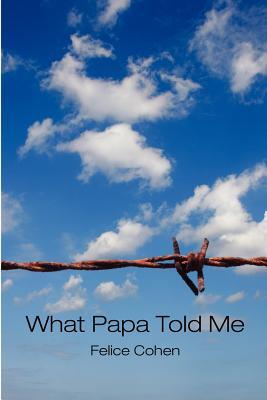
What Papa Told Me
Sunday to Thursday: 09:00-17:00
Fridays and Holiday eves: 09:00-14:00
Yad Vashem is closed on Saturdays and all Jewish Holidays.
Entrance to the Holocaust History Museum is not permitted for children under the age of 10. Babies in strollers or carriers will not be permitted to enter.

What Papa Told Me
What Papa Told Me
Felice Cohen
Dividends Press, 2010
110 pages
This is the Holocaust testimony of Murray Schwartzbaum, from Szczekociny, Poland, as told to his granddaughter, Felice Cohen. While many such stories are told in the first-person with the help of a family member, Cohen also includes pieces of her conversation with her grandfather, opening the dialogue with the third-generation, a topic not always incorporated into Holocaust testimonies.
This touching and heart wrenching story begins when Murray is a child, born in 1921, to a traditional Jewish family. Owners of a family-run lumber company, he has fond memories of his sisters and brother and the “normal” life that they all shared. When the Nazis invaded Poland, Murray’s brother escaped to the Soviet Union, while the rest of the family tried to move to Bedzin but quickly learned of the killings of Jews and chose to return to their home. Murray lived most of the war in a series of slave labor camps, eventually being transported to Bergen-Belsen where he found his sister Cecia and learned of the tragic fates of the rest of their family. With his sister’s help, Murray survived and together they were liberated by the American army in 1945. They each married a Holocaust survivor and began rebuilding their lives.
But the story does not end there. Cohen asks her grandfather about her grandparents’ move to the United States and the hardships they faced as Holocaust survivors. Both Murray and his wife Fela were deeply traumatized by what had occurred during the six years of the Nazi occupation. Murray recalled those difficult years and yet the story concludes in an inspiring and uplifting manner, and he explains to Felice the legacy that he has left for her, his other grandchildren, and future generations.
This book can be graphic, exposing the horrors of the Nazi atrocities. Teachers should use their discretion when using this with middle-school students, though there is much to be learned from the story. It is written in an easy-to-understand style and tells the story of people their age who lived in an unfortunately devastating time. Perhaps one of the biggest reasons to use this with students is its emphasis on talking to grandparents, listening to their stories, and retelling them.

Thank you for registering to receive information from Yad Vashem.
You will receive periodic updates regarding recent events, publications and new initiatives.

"The work of Yad Vashem is critical and necessary to remind the world of the consequences of hate"
Paul Daly
#GivingTuesday
Donate to Educate Against Hate


Worldwide antisemitism is on the rise.
At Yad Vashem, we strive to make the world a better place by combating antisemitism through teacher training, international lectures and workshops and online courses.
We need you to partner with us in this vital mission to #EducateAgainstHate
The good news:
The Yad Vashem website had recently undergone a major upgrade!
The less good news:
The page you are looking for has apparently been moved.
We are therefore redirecting you to what we hope will be a useful landing page.
For any questions/clarifications/problems, please contact: webmaster@yadvashem.org.il
Press the X button to continue



